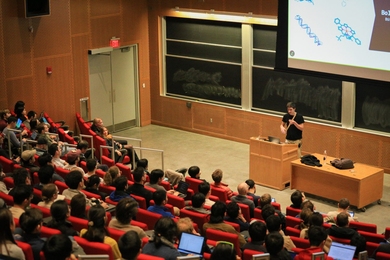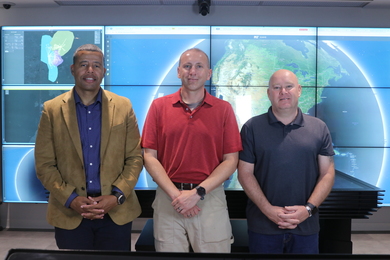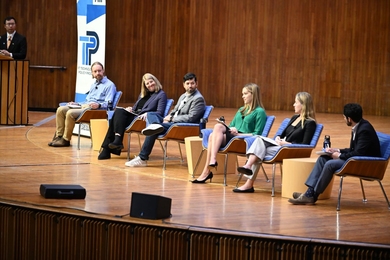The Executive Committee has approved the promotion of 14 associate professors to the rank of full professor, effective July 1. Twenty-eight assistant professors were also promoted to associate professor without tenure (see accompanying article).
At a separate meeting, the Executive Committee also approved the awarding of tenure to 23 faculty members. These appointments will be reported in a later issue of MIT Tech Talk.
Those promoted to full professor are:
SCHOOL OF ENGINEERING
Dr. Anant Agarwal in the Department of Electrical Engineering and Computer Science. Professor Agarwal received the BTech from the Indian Institute of Technology in 1982, and the MS (1984) and PhD (1987) from Stanford University, all in electrical engineering. He joined the MIT faculty in 1988 as an assistant professor, was promoted to Jamie-son Career Development Associate Professor in 1992 and awarded tenure in 1994. He received a Presidential Young Investigator Award in 1991. Professor Agarwal's research is in computer architecture. He is credited with changing the way people build and use shared-memory multiprocessors through the MIT Alewife machine, whose novel features include a software directory approach and an integration of message-passing and shared memory. His current research focuses on creating microprocessors for future billion-transistor-chip technologies. His latest project, Raw, is an attempt to build a revolutionary microprocessor that will allow users to run multimedia computations at speeds which are orders of magnitude faster than on today's machines, and at the same time run traditional, number-crunching applications at speeds comparable to existing microprocessors.
Dr. Louis L. Bucciarelli Jr. of the School of Engineering and the Program in Science, Technology and Society (School of Humanities, Arts and Social Sciences). Professor Bucciarelli received the BME (1959) and a master's degree in aeronautic engineering (1960) from Cornell University and the PhD in aeronautics and astronautics (1963) from MIT. He was named associate professor in 1971 and served as director of the Technology Studies Program from 1974-80. Internationally recognized for his research on engineering design as a negotiation process (Designing Engineers, MIT Press, 1994), he currently leads a comparative study of engineering practice in France and the United States with funding from France Telecom. His research has had a direct impact on the renovation of engineering education through his efforts as co-principal investigator for the NSF-funded Engineering Coalition of Schools for Excellence in Education and Leadership.
Dr. Wai K. Cheng in the Department of Mechanical Engineering. Dr. Cheng received the BS in engineering and applied science in 1974 from the California Institute of Technology, and the SM (1975) and the PhD (1979) in aeronautics and astronautics from MIT. He was a senior research scientist at Aerodyne Research from 1978-80 before joining the MIT faculty in 1980. He was named the Carl Richard Soderberg Assistant Professor in Power Engineering in 1982, promoted to associate professor in 1985 and awarded tenure in 1986. Professor Cheng, who has been associate director of the Sloan Automotive Laboratory since 1992, is an expert in internal combustion engines. His work has enabled automobile companies to reduce hydrocarbon emissions substantially in passenger cars. He helped develop a device to measure hydrocarbons in running engines in real time, and established the theoretical background and practical applications of the measurement system in engine environments. He is former associate editor for the Internal Combustion Engine section of the ASME Journal of Gas Turbines and Power (1994-96), and the 1984 recipient of the Society of Automotive Engineering Teetor Award.
Dr. Munther A. Dahleh in the Department of Electrical Engineering and Computer Science. Professor Dahleh received the BSEE in 1983 from Texas A&M University and the PhD in electrical engineering from Rice University in 1987. He came to MIT as an assistant professor in 1987, was promoted to associate professor in 1991, was named Finmeccanica Career Development Professor in 1992 and awarded tenure in 1994. He received the Graduate Council Teaching Award in 1995, the Eckman Award of the American Control Council (1993) and the Presidential Young Investigator Award (1991). Professor Dahleh, whose research is in the area of control theory, created a new paradigm for robust control that is now a fully developed design methodology. His most recent theoretical work extended that methodology to linear problems with mixed objectives, and he is now developing a computational theory of robust nonlinear control. He also pioneered a fundamental rethinking of system identification. Professor Dahleh's interdisciplinary research includes the modeling of the cerebellum as the center for motor control functions. Professor Dahleh is co-author of Control of Uncertain Systems: A Linear Programming Approach (Prentice Hall, 1995).
Dr. Martha L. Gray in the Department of Electrical Engineering and Computer Science and the Division of Health Sciences and Technology (HST). She received the BS in computer science from Michigan State University in 1978, and the SM in electrical engineering (1981) and PhD (1986) in medical engineering from MIT. Dr. Gray joined the MIT faculty in 1987 as the J.W. Kieck-hefer Assistant Professor, was promoted to J.W. Kieckhefer Associate Professor in 1992, awarded tenure in 1994 and now serves as co-director of HST. Dr. Gray's research objective is to develop the science and technology that will lead to clinically useful diagnostic tools and therapies for joint diseases such as osteoarthritis. Towards that end, she pioneered the development of magnetic resonance imaging techniques that are capable of measuring cartilage composition nondestructively in vivo and in vitro. She also invented a precision cell-stretching apparatus used in the study of bone-cell biosynthesis.
Dr. Martin A. Schmidt in the Department of Electrical Engineering and Computer Science. He received the BSEE from Rensselaer Polytechnic Institute in 1981 and the SM and PhD from MIT in 1983 and 1988. Professor Schmidt was named Joseph F. and Nancy P. Keithley Career Development Assistant Professor in 1988, the Carl Richard Soderberg Assistant Professor in Power Engineering in 1991 and the Soderberg Associate Professor in 1992, and he was awarded tenure in 1994. He has been associate director of the Microsystems Technology Laboratories since 1997. Professor Schmidt is an expert in MEMS (MicroElectroMechanical Systems), devices with miniature moving parts made with fabrication techniques of microelectronics. His current research projects involve novel applications of MEMS technologies to a variety of fields, including miniature gas turbines, miniature chemical reactors, microswitches, biological applications and sensors monolithically integrated with electronics.
Dr. Alexander H. Slocum of the Department of Mechanical Engineering. Professor Slocum received the SB degree in mechanical engineering (1982), the SM (1983) and the PhD (1985), all from MIT. He became assistant professor in civil engineering at MIT in 1985 and in the Department of Mechanical Engineering six years later. He is known for innovative teaching of engineering and for accomplishments in precision engineering, which include the invention of many new mechanisms. He wrote Precision Machine Design, which has become the classic text in the field. A creative and demanding teacher with a strong student following, Professor Slocum has created educational summer programs for inner-city children and is a mentor to younger colleagues.
Dr. Kamal Youcef-Toumi of the Department of Mechanical Engineering. Professor Youcef-Toumi received the BS degree from the University of Cincinnati in 1979 and both the SM (1981) and the ScD (1985) from MIT. He was an assistant professor from 1986-89, when he was named associate professor. An expert on applied control systems, Professor Youcef-Toumi works in the fields of time-delay control; zero-dynamics; modeling, simulation and design of dynamical systems; and atomic-scale resolution systems. He has developed new tools for modeling, analyzing and designing dynamical systems. A dedicated teacher and prolific writer, he has more than 100 refereed publications in journals and conference proceedings.
SCHOOL OF SCIENCE
Dr. Paul T. Matsudaira of the Department of Biology. Professor Matsudaira received the BA and BS from the University of Washington in Seattle (1975) and the PhD from Dartmouth College (1981). He was a post doctoral research fellow at the Max Planck Institute for Biophysical Chemistry in Germany (1981) and a postdoctoral fellow at the Medical Research Council Laboratory of Molecular Biology in Cambridge, England (1981-84). He came to MIT as an associate member of the Whitehead Institute and an assistant professor in the department of biology (1985-89), becoming an associate member of the Whitehead Institute and an associate professor of biology (1989-92), and a member of the Whitehead Institute and an associate professor with tenure in 1992. He became a member of the Center for Biomedical Engineering in 1995. In addition, Professor Matsudaira has established a successful engineering group that is setting the performance limits for microfabricated DNA micro-phoresis devices. He edits several print journals and video series and is one of the authors of the textbook Molecular Cell Biology.
Dr. Terry L. Orr-Weaver of the Department of Biology. Professor Orr-Weaver received the BA in chemistry from the University of California at San Diego (1977) and the PhD in biochemistry from Harvard University (1984). She subsequently became a postdoctoral fellow in the department of embryology at Carnegie Institution of Washington. She came to MIT as an associate member of the Whitehead Institute and an assistant professor of biology (1987-92), later becoming an associate professor (1992-94) and a member of the Whitehead Institute and an associate professor with tenure in 1994. Professor Orr-Weaver's research, which focuses on control of cell division during development, recently identified a protein that binds to the centromeres of chromosomes to ensure their proper segregation. She is a member of the National Science Foundation, the Molecular and Cellular Biosciences Review panel (1997-2000) and has been on the editorial board of Chromosoma since 1995. She was a Searle Scholar (1988-91) and has held the Latham Family Development Chair (1991-94).
SCHOOL OF HUMANITIES AND SOCIAL SCIENCE
Dr. Joshua Angrist of the Department of Economics. Professor Angrist received the BA in economics (1982) from Oberlin College, and a master's degree (1987) and PhD (1989) in economics from Princeton University. A labor economist and applied econometrician, Professor Angrist joined the MIT faculty as a tenured associate professor in 1996. Previously, he worked at Harvard and the Hebrew University of Jerusalem. His research on the measurement of the effect of military service, schooling, elementary school class size, and family size and structure on wages and labor supply decisions has had an important impact on the labor economics field. In addition to creating the successful Harvard-MIT Data Center, which is available to MIT faculty and students for teaching and research, he also played a major role in improving the quality of the computer infratructure of the economics department. He serves on the editorial boards of several economics journals, is a research associate at the National Bureau of Economic Research and serves as an advisor to government task forces evaluating the effects of welfare reform.
Dr. Jeffrey E. Harris of the Department of Economics. Professor Harris received the AB summa cum laude (1969) from Harvard College, the MD degree from the University of Pennsylvania in 1974 and the PhD in economics from the University of Pennsylvania in 1975. He did a residency and fellowship in internal medicine at Massachusetts General Hospital from 1974-77. A health economist and physician on the MIT faculty since 1975, Dr. Harris is the nation's leading authority on the economics of the tobacco industry and the effects of alternative legal and regulatory policies on smoking. A popular and outstanding teacher, Dr. Harris attracts nearly 100 MIT undergraduates each year to a course he developed on health economics.
SLOAN SCHOOL OF MANAGEMENT
Dr. Deborah G. Ancona of the Sloan School of Management. Professor Ancona received the BA (1976) and the MS in counseling Psychology (1977) from the University of Pennsylvania at Philadelphia, and the PhD in organizational behavior from Columbia University. She came to MIT as a visiting assistant professor (1985-86) in organizational studies. She was later named an assistant professor (1986-89), associate professor (1989-1992) and associate professor with tenure (1992). Her principal fields of interest include organizational behavior, group process and performance, boundary spanning, new product teams, and top management teams. Her research focuses on the interchange between the group and its environment. Professor Ancona is a member of the Academy of Management, the American Psychological Association, and the Society for Industrial and Organizational Psychology.
Dr. Jiang Wang of the Sloan School of Management. Professor Wang received the BS in physics from Nanjing University (1981) and the PhD in physics (1985) as well as the PhD in finance (1990) from the University of Pennsylvania. Professor Wang came to MIT as the NTU Career Development Assistant Professor (1990-94). He became the NTU Career Development Associate Professor (1994-95), the Ford Foundation Career Development Professor (1995-96) and the Sloan School Career Development Associate Professor in 1996. His principal field of interest is financial economics. Professor Wang is the associate editor of The Review of Financial Studies and The Journal of Financial Markets, and he is a member of the Econometric Society, the Society of Financial Studies and the American Financial Association.
A version of this article appeared in MIT Tech Talk on May 6, 1998.





